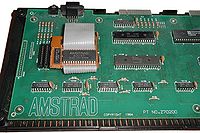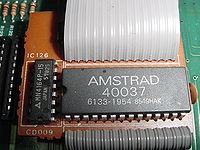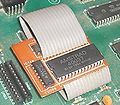Difference between revisions of "472"
(→Description) |
m (→Description) |
||
| Line 14: | Line 14: | ||
* The CPC472 itself was sold for '''how many?''' pesetas ('''how many?''' euros) | * The CPC472 itself was sold for '''how many?''' pesetas ('''how many?''' euros) | ||
| − | (For reference, prior to the introduction of this law, a CPC464 system ''including green screen monitor'' was sold for only 25,000 to 30,000 pesetas / 150 to 180 euros (as per [http://www.amstrad.es/forum/viewtopic.php?f=19&p=18955#p19008 THIS] admittedly anecdotal forum post...) | + | (For reference, prior to the introduction of this law, a CPC464 system ''including green screen monitor'' was sold for only 25,000 to 30,000 pesetas / 150 to 180 euros (as per [http://www.amstrad.es/forum/viewtopic.php?f=19&p=18955#p19008 THIS] admittedly anecdotal forum post...)) |
Because there was no space for a new chip, Amstrad designers took off the ROM chips, and put it in a daughter board, along with the extra 4164 RAM chip. Wires connected pins at the ROM from the daughter board to the corresponding pins on the main board. The wires were hard enough to make difficult to turn the daughter board over and reveal the trick: no wires were connected from the DRAM chip to the main board. Even the supply pins were not connected!! | Because there was no space for a new chip, Amstrad designers took off the ROM chips, and put it in a daughter board, along with the extra 4164 RAM chip. Wires connected pins at the ROM from the daughter board to the corresponding pins on the main board. The wires were hard enough to make difficult to turn the daughter board over and reveal the trick: no wires were connected from the DRAM chip to the main board. Even the supply pins were not connected!! | ||
Revision as of 08:33, 5 February 2013
The CPC 472 was a spanish version of the CPC 464 with additional (nonfunctional) 8 KB RAM.
Contents
Description
The reason Amstrad released a special version for the spanish market was a import tax on computers with 64K or less RAM. So Amstrad soldered in an extra 8KB which was not, however, usable by the machine since it was not connected to anything else.
The tax is said to have been at least 15,000 pesetas per computer. For reference:
- 15,000 pesetas are approximately 90 euros. (As per THIS converter)
- The CPC472 itself was sold for how many? pesetas (how many? euros)
(For reference, prior to the introduction of this law, a CPC464 system including green screen monitor was sold for only 25,000 to 30,000 pesetas / 150 to 180 euros (as per THIS admittedly anecdotal forum post...))
Because there was no space for a new chip, Amstrad designers took off the ROM chips, and put it in a daughter board, along with the extra 4164 RAM chip. Wires connected pins at the ROM from the daughter board to the corresponding pins on the main board. The wires were hard enough to make difficult to turn the daughter board over and reveal the trick: no wires were connected from the DRAM chip to the main board. Even the supply pins were not connected!!
The CPC 472 with spanish or british keyboard is very very rare.
In some interviews, Amstrad developers stated that they have never heard of the CPC472, so it's possible that the daughterboard was made by Indescomp (the spanish distributor), not by Amstrad.
Timeline
1. CPC464 with British Keyboard
Before the special taxes were invented (ie. until September 1985), the normal CPC464 with 64K RAM, english keyboard, and english CPC464 ROM (40009) have been sold in spain.
2. CPC472 with British Keyboard
Faked 72K RAM to bypass the Import Tax on models with 64K or less RAM. These units included a CPC664 ROM (40022) (that is, not CPC464 ROM), thus supporting Locomotive BASIC 1.1 - the spanish manual claimed that the extra 8K would be required for BASIC 1.1 - this was total nonsense, but it "explained" why users didn't have access to the extra memory: it was "reserved" for BASIC.
3. CPC472 with Spanish Keyboard
After another law added Spanish Keyboard Requirement, the CPC472 was fitted with spanish keyboard, and spanish CPC464 ROM (40037). But still including the 72K daughterboard.
4. CPC464 with Spanish Keyboard
The 64K-related Import Tax was dropped when spain joined the EEC, and so, the fake 72K project was discontinued, and the CPC464 was re-invented. But now having spanish CPC464 ROM (40037) and spanish keyboard.
The Daughterboard
The picture of the desoldered MS0043A board shows the fake connections: Only the ROM (IC103) connects to the ribbon cable. The wires going to IC126,IC127,IC128 do end shortly before actually reaching the soldering points; this is hidden underneath of the white paint layer - but still visble when having a closer look. There are even a few perfectly visible interruptions that aren't covered by paint (seen near IC126).
- Daughterboard
The 8KB extra memory, was a 4164 DRAM chip (64Kx1bit). The DRAMs 1bit databus didn't suit too well to the Z80s 8bit bus, moreover, the daughterboard didn't receive /RAS and /CAS signals which are usually required for DRAM addressing & DRAM refresh. So, even if it would have been functional, the RAM could have been only accessed via complicated software mechanisms; like loading the address LSBs into IR register, and then INning from address MSBs.
The two logic chips for address decoding (not connected, and non-functional, too) are more or less hidden under the robbon cable. Looking under it reveals a 74LS08 (Quad 2-Input NAND), and a 74LS32 (Quad 2-Input OR), as seen on Miguel Angel's photos. However, on Kevin Thacker's webpage, the second chip is listed as 74LS136 (Open-collector Quad 2-Input XOR) - so, it seems the daughterboards were randomly fitted with whatever cheaply available chips (possibly including damaged chips - can somebody verify that?).
Hypothesis & Facts (compiled by deepfb)
64K RAM Limit
1. Some Spanish companies may have lobbied for a tariff on imported computers, calculators and other electronic machines during the first half of the eighties (*). As a result, the Spanish Government passed an Act (Real Decreto 1215/1985, dated on 17th of July, 1985) that established a tariff on headings 84.52 (calculator and accounting machines, cash registers, etc.) and 84.53 ("automatic machines for data processing", including computers) imported from foreing countries.
2. Foreign computer manufacturers lobbied themselves as a response, and forced the Government to move to an equidistant position: the tariff would be charged only on "micro-computers", that is, "automatic machines for data processing with less than 64 KB of memory". The lobbying movement was so effective that the Spanish Ministro de Economía (equivalent to the head of the British Departments of Commerce and Treasury), Carlos Solchaga, gave up his summer vacation and travelled to Mallorca, were the king was having his holidays, to have the new law signed (Real Decreto 1558/1985, dated on 28th of August, 1985). The urgency of the trip gives an idea of how powerful were foreign computer manufacturers at that time.
3. The tariff charged on imported computers lasted one month only, from the 25th of July to the 3rd of September, 1985. The amount of the tariff per unit ranged from 15,000 to 300,000 pesetas (90 to 1,800 euro at current prices), depending on the type and the value of each particular model. From the 3rd of September, 1985, only computers with less than 64 KB of RAM were charged with the 15,000ptas./90€ tariff, leaving tax-exempt the rest.
4. Amstrad España (Indescomp) wasn't fully satisfied by the tariff discount, and started selling their allegedly 72 KB model (Amstrad CPC 472) on September 1985 to avoid the tariff. My guess is that Amstrad UK was aware of this movement (maybe not his engineers, but at least the sales department), since the computers should arrive at Spain with the legend "72 KB RAM computer" labeled anyplace.
According to Sugar's autobiography "What you see is what you get", Amstrad knew very well what was going on. Beginning of Chapper 9: In August 1985, I had a panicked telephone call from Dominguez telling me there was a serious problem, that all computers of 64k and below were now banned from importation into Spain. This was because a Spanish manufacturer was producing a 64k computer and had managed to get the Spanish government to impose a rule blocking all others. This was a disaster for Dominguez and Amstrad – by now we were selling thousands of computers in Spain. [...] Fortunately, the main operating system ROM chip was fitted on the PCB by means of an IC socket; it wasn’t soldered in permanently. I suggested to my people in Brentwood that we design a mini-PCB which would hold the ROM chip as well as an extra single 64k D-RAM chip (and a few peripheral components). I also asked my technical geniuses to come up with some justification as to what this extra chip was doing, rather than be sitting in mid-air going nowhere. They did – but don’t ask me what it was! This mini-PCB, with its additional D-RAM, then plugged into the original IC socket. Based on this trick, it was true to say that the computer now had 72k of memory. We rushed the design of this mini-PCB to Orion. On top of this, we had to change the faceplate on the front of the computer which was labelled ‘64k, as well as all the packaging and the instruction manual.
5. Spain joined the EEC on 1st of January, 1986. The Government had to align his tariffs policy with that of the EEC, and as a result it has to remove the charges on the heading 84.53 (EEC Commission Decision 1985/80908, dated on 15th of November, 1985). There was no point in marketing the CPC 472 model from then on.
- (*) One of them may have been Eurohard, the Spanish company that bought the rights on the Dragon range of computers to Dragon Data at the end of 1984. Eurohard was manufacturing and selling 32 KB and 64 KB computers at that time -the Dragon 32, Dragon 64 & Dragon 200 models-, and developing a MSX-1 compatible computer with no more than 64 KB of RAM.
Keyboard Layout
Making the spanish keyboard compulsory for every home computer is not related at all with the marketing of the 472 model. The confusion of 72K RAM and Spanish Keyboard comes from the coincidence in time of the Acts setting the new tariffs (RD 1215/1985 and RD 1558/1985) and the Acts that made compulsory the inclusion of the Ñ key (RD 1250/1985 and RD 2707/1985).
When spain became an EEC member, only the 64K import tax was dropped. The obligation of marketing computers with a spanish keyboard is still valid. Making compulsory to sell a particular, language-specific keyboard can be seen as an anti-free trade regulation, but at the end the EEC allowed this kind of national regulations in order to preserve the cultural heritage of each country.
More Pictures
- CPC472
The Manual
The CPC472 came with some bizarre aspects, too. Reading 464 on the cover, but 472 on the bookneck. And, claiming that the 72K RAM would be required because of using the ROM of the CPC664 (whilst, the real CPC664 has only 64K RAM).














